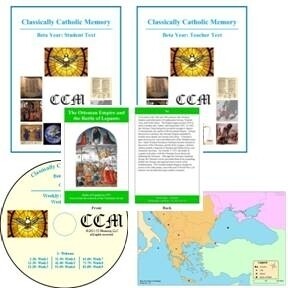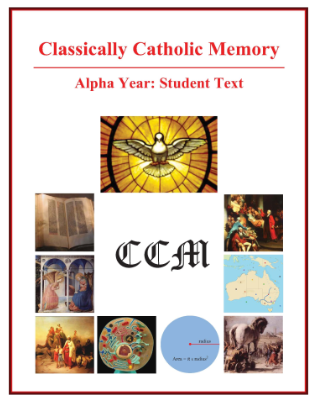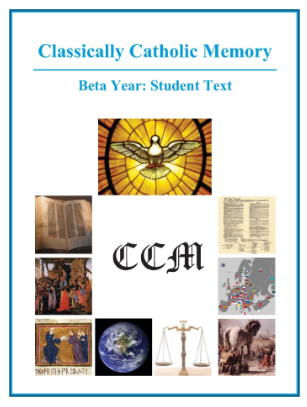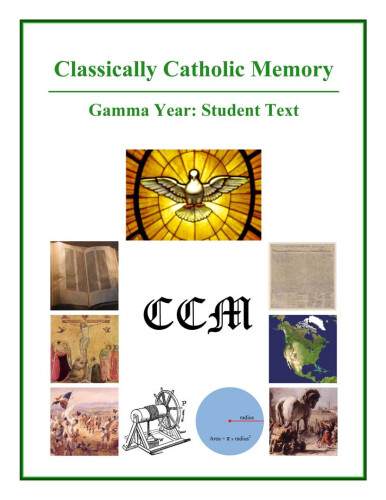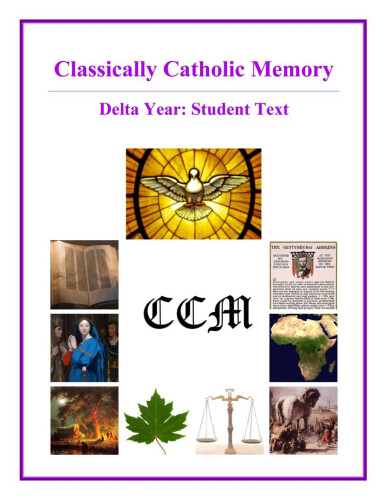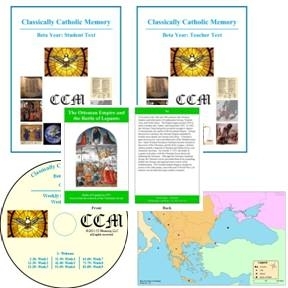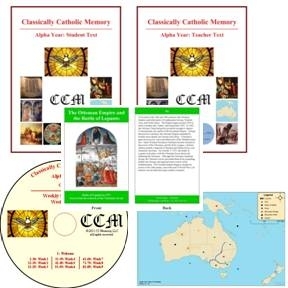Classically Catholic Memory
In Brief ...
-
-
CCM is a "memory work" program. This means that its goal is aiding students in the process of internalizing core knowledge.
-
CCM is Catholic in the manner in which it incorporates theology, scripture, the Lives of the Saints, and the Church's outlook on history and man.
-
CCM is Classical, first and foremost simply for its emphasis on the importance of memorization in the grammar stage, but also for the inclusion of Latin, an emphasis on the importance of beautiful and elevated language, and its depth of history.
-
Carefully-organized knowledge sets in eight subjects: Religion, Latin, History, Science, Math, Timeline, Geography, and Great Words.
-
Memorization is facilitated through beautiful visual presentation and musical sing-alongs, allowing everyone to learn together.
-
Designed for K-6th grades; suitable for all grades (and parents too) and arranges content on a 4 year repeating cycle.
-
Works well as a spine around which to organize other subjects or as a supplement to nearly any existing program.
-
In Depth ...
Why Memory Work? Some might consider memorization outdated as there is definitely a modern educational bias against having children memorize much of anything. Mastering a large amount of factual material over a broad range of subjects is exactly what should provide the “raw material” for those higher order thinking skills as children mature. Understanding, analyzing, evaluating, comparing, contrasting, synthesizing, and clearly expressing oneself are certainly critical skills…but if the child has never mastered the core facts of a particular subject, what is there to analyze, or evaluate, or form and express a clear opinion on?
In addition, the memorization of certain subjects has particularly unique benefits. When a child memorizes beautiful, classic poetry, he is internalizing complex, varied sentence patterns, as well as vocabulary that is generally more sophisticated than the everyday words he hears. In addition, he is being exposed to inspiring thoughts and ideals that have been expressed in memorable ways. When a child memorizes, word for word, traditional explanations of Catholic doctrine such as those found in the Baltimore Catechism, he is accomplishing something that will benefit him all his life: namely, the ability to clearly express his faith in exact, precise terms, which will act as a safeguard against the vagueness and lack of clarity that can gradually endanger one’s faith. The following is a quote from Bl. John Paul II:
Those of us who grew up in the 1970s and 1980s certainly know what he meant about the “desert place of a memory-less catechesis”! But, it is exactly as he so eloquently says--memorization and understanding, in all subjects, must go hand-in-hand. It is not a case of choosing one or the other, but knowing the importance of both. What does this look like in homeschooling our children? It means we continue to do interesting and engaging projects, nature walks, science demonstrations, and reading and discussion of good literature and great ideas…but we also spend time and effort on challenging our children to memorize a wealth of material that will benefit them enormously throughout their lives!
“A certain memorization of the words of Jesus, of important Bible passages, of the Ten Commandments, of the formulas of profession of the faith, of the liturgical texts, of the essential prayers, of key doctrinal ideas, etc., far from being opposed to the dignity of young Christians, or constituting an obstacle to personal dialogue with the Lord, is a real need, the Synod Fathers forcefully recalled. We must be realists. The blossoms, if we may call them that, of faith and piety do not grow in the desert places of a memory-less catechesis. What is essential is that the texts that are memorized must at the same time be taken in and gradually understood in depth, in order to become a source of Christian life on the personal level and the community level.” CATECHESI TRADENDAE (On Catechesis In Our Time) John Paul II - Apostolic Exhortation of His Holiness to the Episcopate, the Clergy and the Faithful of the Entire Catholic Church given on 16 October 1979.
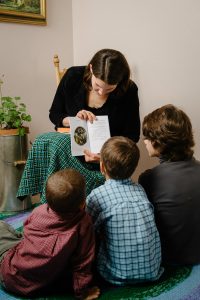 How is CCM Catholic? CCM is Catholic in the manner in which it incorporates theology, scripture, the Lives of the Saints, and the Church's outlook on history and man. First and foremost, we have as our goal the teaching of our children to love Jesus Christ and his bride, the holy Catholic Church, through whom He speaks. To this end, we teach both Scripture and Catechism in the one subject, Religion; we also teach traditional and beautiful Catholic prayers and hymns that are part of our heritage as Catholics. Our history and timeline components spring from the perspective that history is not divided into “Biblical history” and “secular history”; all of history is the story of God’s action in the world, preparing a people for Himself; preparing the world for the central event of history, the Incarnation; redeeming the world; and advancing His redeeming work by the action of the Holy Spirit in the Church. Our children must see all aspects of history—the seemingly secular and the overtly religious—as part of one whole. The same Moses who led the Israelites out of Egypt grew up in the land of the Nile and the land of the pyramids, and lived close in time to such famous pharaohs as Hatshepsut and Tutankhamen.
How is CCM Catholic? CCM is Catholic in the manner in which it incorporates theology, scripture, the Lives of the Saints, and the Church's outlook on history and man. First and foremost, we have as our goal the teaching of our children to love Jesus Christ and his bride, the holy Catholic Church, through whom He speaks. To this end, we teach both Scripture and Catechism in the one subject, Religion; we also teach traditional and beautiful Catholic prayers and hymns that are part of our heritage as Catholics. Our history and timeline components spring from the perspective that history is not divided into “Biblical history” and “secular history”; all of history is the story of God’s action in the world, preparing a people for Himself; preparing the world for the central event of history, the Incarnation; redeeming the world; and advancing His redeeming work by the action of the Holy Spirit in the Church. Our children must see all aspects of history—the seemingly secular and the overtly religious—as part of one whole. The same Moses who led the Israelites out of Egypt grew up in the land of the Nile and the land of the pyramids, and lived close in time to such famous pharaohs as Hatshepsut and Tutankhamen.
When our children hear in Scripture that Jesus Christ was born “during the reign of Caesar Augustus”, we want them to be able to form in their minds a picture of the Roman Empire—from its founding in 753 B.C. through its history of kings, Republic, and finally, Empire. When they read in Scripture about Paul’s missionary journeys, we don’t want them to consider him as just a religious figure in the Bible that somehow existed apart from the civilizations surrounding him. Rather, as they read about him speaking to the Greeks about their “statue to an unknown god”, we want them to have some understanding of Greek culture, Greek civilization, and the Greek mind—the searching for truth—that was part of God’s particular preparation of the Greeks to hear about His Son.
How is CCM Classical? CCM is classical, first and foremost simply for its emphasis on the importance of memorization in the grammar stage, but also for the inclusion of Latin, an emphasis on the importance of beautiful and elevated language, and its depth of history.
Classical education has been defined in a multitude of ways, ranging from precise curriculum characteristics to a more general philosophical focus. We like Matthew Arnold’s phrasing of “the best that has been thought and said” to describe, in a nutshell, what we place before our students as worthy of knowing about, reflecting upon, and imitating. One key characteristic of classical education is a focus on classical civilizations (Greece and Rome), and on the interplay between Greek, Roman, and Hebrew civilization that contributed to the founding of Christian society. The study of history is orderly and chronological; history did not begin with George Washington! When our children study George Washington, for example, we want them to understand references to the great Roman hero Cincinnatus.
In all of their studies and throughout their lives, they will need to understand the many references to classical civilizations that they will come across. They will study what came “in the beginning” in order to understand later ideas, events, and persons. In the history component of Classically Catholic Memory, children will spend a great deal of time learning about classical civilizations, from Greek philosophers, the Peloponnesian War, Homer, and Alexander the Great, to the founding of Rome, the Punic Wars, and Julius Caesar. What they learn in history will be reinforced by their memorization of the Timeline—the names of 144 important events and persons to be recited chronologically from Creation to John Paul II.
Overview of Years, Materials, and Subjects
An overview of years, materials, and subjects is all that is needed to understand what Classically Catholic Memory provides. This program may be used successfully alongside any homeschool curriculum. There is a special, 3-year cycle Schola Rosa edition for the Schola Rosa curriculum.
Overview of Years
Classically Catholic Memory is a four-year program. The years are named Alpha, Beta, Gamma, and Delta, and each year provides 18 weeks of memory work. The years may be completed in any order. The major differences among years are mainly in the subjects of history, science, and geography, as each of these subjects has a different focus in the different years. The other subjects provide varied material that is not necessarily correlated with any one topic or area of focus, except for Timeline, which is repeated every year.
Religion:
Each year provides various Catechism questions and answers and passages from Scripture.
Latin:
Each year provides various prayers and hymns.
History:
History sentences from one of four time periods:
- Alpha Year: Creation through the Birth of Christ (Ancients)
- Beta Year: The Time of Christ through 1500 (Middle Ages)
- Gamma Year: 1500 through 1800 (Early Modern Times)
- Delta Year: 1800 through Modern Times (Later Modern Times)
Science:
Science questions and answers from one of four science topics:
- Alpha Year: Life Science: Animal Life
- Beta Year: Earth Science and Astronomy
- Gamma Year: Chemistry and Physics
- Delta Year: Life Science: Human Anatomy and Physiology and Plant Life
Math:
Skip counting (every year)
- Alpha and Gamma Years: Geometric Formulas
- Beta and Delta Years: Conversion Formulas
Timeline:
The same timeline is learned every year.
Geography:
Countries, some capital cities, and physical geography of either one or two continents per year.
- Alpha Year: Asia and Australia
- Beta Year: Europe
- Gamma Year: North America
- Delta Year: Africa and South America
Great Words I and II:
Every year provides material that includes poems, historical documents, and speeches.
Overview of Materials
Student Text: The Student Text contains the memory work for each subject, broken down by week, and includes a weekly summary sheet for each week. Almost every page includes beautiful, full-color artwork from great artists, chosen to enhance the student’s understanding of the main topic of each subject in each week.
Teacher Text: The Teacher Text contains introductory material explaining the relationship and importance of memory work to a classical education; a full explanation of the Classically Catholic Memory program; teaching techniques and strategies for each subject; the entire student text in a smaller size form; detailed background information for each week of science, along with multiple options for science activities to go along with each week’s material; background information for the history sentences; suggested activities for the math memory work; and more.
Maps and Stickers: The map set consists of five laminated maps of either one or two continents for the student to label with the included stickers. Most countries on each continent are included (countries that are excluded are primarily very small island countries), along with major capital cities, states of the U.S. (in the North America set), and physical geography. A map of the entire continent is included on the back of all maps so that the child can trace country and continent borders to gain familiarity with the geography of each continent.
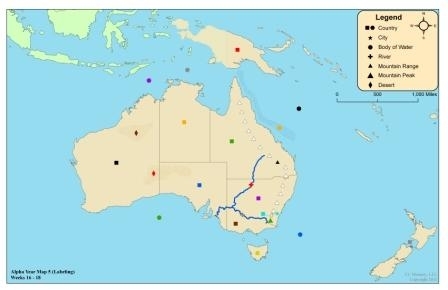
3-CD set: All of the memory work is contained on a set of three (3) audio CDs. CDs 1 and 2 contain the memory work broken down by week, while CD 3 contains the memory work broken down by subject for easy review and mastery. Math skip-counting (2s through 12s) and all of the history sentences are sung to easy-to-recognize tunes to aid in mastering the material.
Timeline Cards: This set contains 144 4x6 full-color cards depicting events and persons from Creation through Pope John Paul II. 15 essential dates are included on certain critical events in the timeline. The front of each card contains the name of the event/person along with famous artwork, maps, or photographs depicting that event/person. The back contains detailed information, or Scriptural references, about that particular event/person. The cards are clearly labeled in numerical order on the back of each card.
Which materials are necessary? It is best if each family has, for each year, at least one Student Text, one Teacher Text, one CD set, and at least one set of maps and stickers; the same set of Timeline Cards can be used each year, so it is only necessary to buy one set. In some families, it may be best if each student who is "participating" in the program, and who can read, has his or her own Student Text and possibly his or her own map set. However, sharing and copying materials within a family is permissible. Copying materials for other families, including in a co-op setting, is NOT acceptable. Please make sure each family in a co-op purchases their own materials. Remember that the timeline cards are a one-time purchase, as the same timeline is learned every year.
Overview of Subjects
The subjects covered in CCM are: Religion, Latin, History, Science, Math, Timeline, Geography, and Great Words I and II.
Religion:
Divine revelation is contained in both the written word of God (Scripture), and the unwritten word of God (Tradition). Therefore, the religion memory work provides material for both Scripture memorization and the memorization of Catechism questions and answers (which are taken from The New St. Joseph Baltimore Catechism #2). Scripture is the inspired word of God, and as such is worthy of memorization.
“Sacred Scripture is the speech of God as it is put down in writing under the breath of the Holy Spirit.” (Dei Verbum, 1965)
The Catechism explains the central tenets of our Catholic faith.
“Tradition transmits in its entirety the Word of God which has been entrusted to the apostles by Christ the Lord and the Holy Spirit. [The Church] does not derive her certainty about all revealed truths from the holy Scriptures alone. Both Scripture and Tradition must be accepted and honored with equal sentiments of devotion and reverence.” (Dei Verbum, 1965)
Sample from Beta Year, Week 5:
Q: "What are the principal ways of obtaining grace?" A: "The principal ways of obtaining grace are prayer and the sacraments, especially the Holy Eucharist."
Latin:
The Latin portion of the CCM program consists of Latin prayers and hymns. Latin is the universal language of the Church, and learning hymns and prayers in Latin allows one to enter more deeply into the liturgy and history of the Church. Unlike other memory work programs, CCM does not include Latin grammar memorization. Why? Memorizing Latin grammar is very important (for students of Latin), but it is also relatively easy to simply follow one’s chosen Latin program in the memorization of the grammar. CCM tries to provide assistance with the areas in which parents might have more difficulty deciding what students should memorize.
Sample from Delta Year:
Tantum Ergo
History:
Every week, students memorize several sentences containing detailed information about a particular topic in history. The history sentences contain important information from one of four time periods. They are chronological, and provide an excellent overview of history from Creation through modern times.
- Alpha Year: Creation through the Birth of Christ (Ancients)
- Beta Year: The Time of Christ through 1500 (Middle Ages)
- Gamma Year: 1500 through 1800 (Early Modern Times)
- Delta Year: 1800 through Modern Times (Later Modern Times)
The history sentences have been put to various well-known tunes on the CCM audio CDs.
Sample from Alpha Year, Week 3:
"Egyptian civilization began along the Nile River. Egyptian history is divided into the Old Kingdom, the Middle Kingdom, and the New Kingdom. The pyramids were built during the Old Kingdom. Important pharaohs of the New Kingdom included Thutmose, Hatshepsut, Amenhotep, and Tutankhamen." Sung to the tune of "Hickory Dickory Dock"
Science:
Every week, students memorize a science question and its answer. The material is arranged topically according to year.
- Alpha Year: Life science: Animal Life
- Beta Year: Earth Science and Astronomy
- Gamma Year: Chemistry and Physics
- Delta Year: Life Science: Human Anatomy and Physiology and Plant Life
In the Teacher Text, every science question and answer is also accompanied by at least one, and sometimes several activities that are strongly related to the memory work for that week. The activities encourage the child to directly apply and practice the science concepts. Examples of activities include a crayfish dissection, nature sketches, making sandstone, constructing models of atoms and molecules, and many others.
Sample from Alpha Year, Week 4:
Q: "What are the major characteristics of the phylum arthropoda?" A: "Arthropods have an exoskeleton, jointed appendages, and a segmented body."
Math:
The first 11 weeks of every year focus on skip counting up through the 12s (skip-counting is just a simplified version of the multiplication tables). Skip-counting is learned to various tunes (similar to the history sentences). The last 7 weeks focus on geometric formulas in the Alpha and Gamma years, and conversion formulas in Beta and Delta years.
Sample from Alpha Year, Week 15:
"The area of a triangle equals one-half its base times its height."
Timeline:
Every year, students memorize a timeline of 144 events and persons from Creation through modern times. The children learn eight cards per week. With encouragement and practice, some of the students will be able to recite the entire timeline by the end of the year. Others will need more time, which is why the timeline work does not change from year to year. Memorizing a complete timeline is important for students to become familiar with the chronology of history. The front of each card contains the name of the event or person, along with famous artwork, maps, or photographs depicting that event or person. The back contains detailed information or Scriptural references about that particular event or person. The cards are clearly labeled in numerical order.
Sample (Card # 81):
Ottoman Turks Capture Constantinople: 1453
Geography:
Each year focuses on one or two continents. The students learn the location of the continents, oceans, nearly all countries, some capital cities, and the most important geographical features such as rivers, mountains, and lakes.
- Alpha Year: Asia and Australia
- Beta Year: Europe
- Gamma Year: North America
- Delta Year: Africa and South America
Great Words:
CCM’s “Great Words” segments consist of poetry, historical documents, and speeches. Great Words is divided into Great Words I and Great Words II. Great Words I is geared towards 5- to 8-year-olds, and consists entirely of age-appropriate poetry. Great Words II is for 9- to 12-year-olds. It consists of a mix of poetry, famous speeches, and excerpts from important documents.
Sample from Great Words I, Beta Year:
"The Owl and the Pussycat" by Edward Lear
Sample from Great Words II, Gamma Year:
Excerpts from The Declaration of Independence


